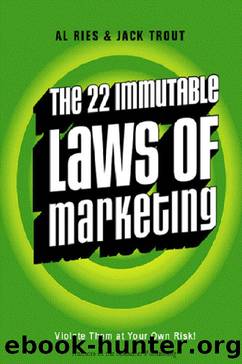The 22 Immutable Laws of Marketing: Exposed and Explained by the World's Two by Al Ries & Jack Trout

Author:Al Ries & Jack Trout [Ries, Al & Trout, Jack]
Language: eng
Format: epub
Tags: Business, Economics, Marketing, Non-Fiction, Industrial, International, Research, Development, Business Development, Direct, Advertising & Promotion, Consumer Behavior, Leadership, Multilevel
ISBN: 9780061798177
Google: MxtRa_ozsewC
Publisher: HarperCollins e-books
Published: 2009-10-12T23:00:00+00:00
12
The Law of Line Extension
Thereâs an irresistible pressure to extend the equity of a brand.
If violating any of our laws was a punishable offense, a large portion of corporate America would be in jail.
By far the most violated law in our book is the law of line extension. Whatâs even more diabolical is that line extension is a process that takes place continuously, with almost no conscious effort on the part of the corporation. Itâs like a closet or a desk drawer that fills up with almost no effort on your part.
One day a company is tightly focused on a single product that is highly profitable. The next day the same company is spread thin over many products and is losing money.
Take IBM. Years ago when IBM was focused on mainframe computers, the company made a ton of money. Today IBM is into everything and barely breaking even. In 1991, for example, IBMâs revenues were $65 billion. Yet the company wound up losing $2.8 billion. Thatâs almost $8 million a day.
In addition to selling mainframe computers, IBM markets personal computers, pen computers, workstations, midrange computers, software, networks, telephones, you name it. IBM even tried to get into the home computer market with the PCjr.
Along the way, IBM dropped millions on copiers (sold to Kodak), Rolm (sold to Siemens), Satellite Business Systems (shut down), the Prodigy network (limping along), SAA, TopView, OfficeVision, and OS/2.
When a company becomes incredibly successful, it invariably plants the seeds for its future problems. Take Microsoft, the most successful company in the software field. (Even though the company is one-fiftieth the size of General Motors, Microsoftâs stock is worth more than GMâs.) What is Microsoftâs strategy? In a word, more.
âMicrosoft Corp. said it is aggressively seeking the dominant share in every major software applications category in the personal computer field,â said the Wall Street Journal recently. âMichael Maples, senior vice president of Microsoftâs applications division, suggested that Microsoft might be able to achieve as much as a 70 percent share in every major applications category,â continued the Journal.
Whom does that sound like? Sounds like IBM. Microsoft is setting itself up as the next IBM, with all the negative implications the name suggests.
Microsoft is the leader in personal computer operating systems, but it trails the leaders in each of the following major categories: spreadsheets (Lotus is the leader), word processing (WordPerfect is the leader), and business graphics (Harvard Graphics from SPC Software Publishing is the leader).
Microsoft keeps puffing itself up by expanding into new categories, such as pen computers. Recently, Microsoft bought Fox Software for $170 million in order to get into the data base software field. (What do you bet the company kills the Fox and changes it to Microsoft?)
There are ominous signs of softness in Microsoftâs strategy. The Economist reported in early 1992, âMr. Gates is putting together a range of products, based on a common core of technology, that will compete across virtually the whole of the software industry: from big computers to small ones,
Download
This site does not store any files on its server. We only index and link to content provided by other sites. Please contact the content providers to delete copyright contents if any and email us, we'll remove relevant links or contents immediately.
| Direct | Global |
| Industrial | Multilevel |
| Product Management | Research |
| Telemarketing | Web Marketing |
Influence: The Psychology of Persuasion by Robert B. Cialdini(4717)
The Miracle Morning by Hal Elrod(4642)
The Hacking of the American Mind by Robert H. Lustig(4319)
Pre-Suasion: A Revolutionary Way to Influence and Persuade by Robert Cialdini(4153)
Unlabel: Selling You Without Selling Out by Marc Ecko(3593)
Ogilvy on Advertising by David Ogilvy(3521)
Hidden Persuasion: 33 psychological influence techniques in advertising by Marc Andrews & Matthijs van Leeuwen & Rick van Baaren(3476)
Purple Cow by Seth Godin(3144)
Who Can You Trust? by Rachel Botsman(3091)
Kick Ass in College: Highest Rated "How to Study in College" Book | 77 Ninja Study Skills Tips and Career Strategies | Motivational for College Students: A Guerrilla Guide to College Success by Fox Gunnar(3077)
The Marketing Plan Handbook: Develop Big-Picture Marketing Plans for Pennies on the Dollar by Robert W. Bly(2978)
This Is Marketing by Seth Godin(2975)
I Live in the Future & Here's How It Works by Nick Bilton(2941)
The Power of Broke by Daymond John(2902)
Building a StoryBrand by Donald Miller(2844)
The Tipping Point by Malcolm Gladwell(2831)
The 46 Rules of Genius: An Innovator's Guide to Creativity (Voices That Matter) by Marty Neumeier(2800)
Draw to Win: A Crash Course on How to Lead, Sell, and Innovate With Your Visual Mind by Dan Roam(2741)
Market Wizards by Jack D. Schwager(2645)
